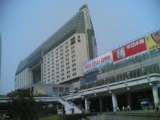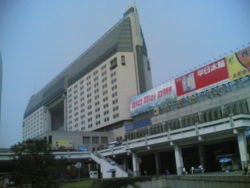
Hangzhou Railway Station
Encyclopedia

Chinese character
Chinese characters are logograms used in the writing of Chinese and Japanese , less frequently Korean , formerly Vietnamese , or other languages...
杭州火车站 or 城站) is located in Shangcheng District
Shangcheng District
Shangcheng District is an administrative district in Hangzhou, Zhejiang Province of China. There lies the ruins of Empire City of Song Dynasty...
, Hangzhou
Hangzhou
Hangzhou , formerly transliterated as Hangchow, is the capital and largest city of Zhejiang Province in Eastern China. Governed as a sub-provincial city, and as of 2010, its entire administrative division or prefecture had a registered population of 8.7 million people...
, Zhejiang Province of China. It is affiliated to Shanghai Railway Bureau
Shanghai Railway Bureau
Shanghai Railway Bureau is a regional bureau affiliated to the Ministry of Railways of the People's Republic of China. As of 2007, the bureau is in charge of a total length of 10,810.5 kilometers, and commercial length of 4,928.1 kilometers of railways. It oversees 503 stations and manages the...
, and is also the terminal of Shanghai-Hangzhou Railway. The station is ranked first-class.
History
.jpg)
Second Sino-Japanese War
The Second Sino-Japanese War was a military conflict fought primarily between the Republic of China and the Empire of Japan. From 1937 to 1941, China fought Japan with some economic help from Germany , the Soviet Union and the United States...
began. The station was bombarded twice in October by Japanese, and Hangzhou was occupied on 24 December. During Japanese occupation in Hangzhou, the station was rebuilt from 26 March 1941 to 21 March 1942, and its appearance resembled the style in Japan's Nara period
Nara period
The of the history of Japan covers the years from AD 710 to 794. Empress Gemmei established the capital of Heijō-kyō . Except for 5 years , when the capital was briefly moved again, it remained the capital of Japanese civilization until Emperor Kammu established a new capital, Nagaoka-kyō, in 784...
.
As the passenger load continuously grew, the station's capacity could hardly cope with the future demands. Therefore, the old station was pulled down in 1997, and the new station was erected in 1999, and put into use on 28 December.

